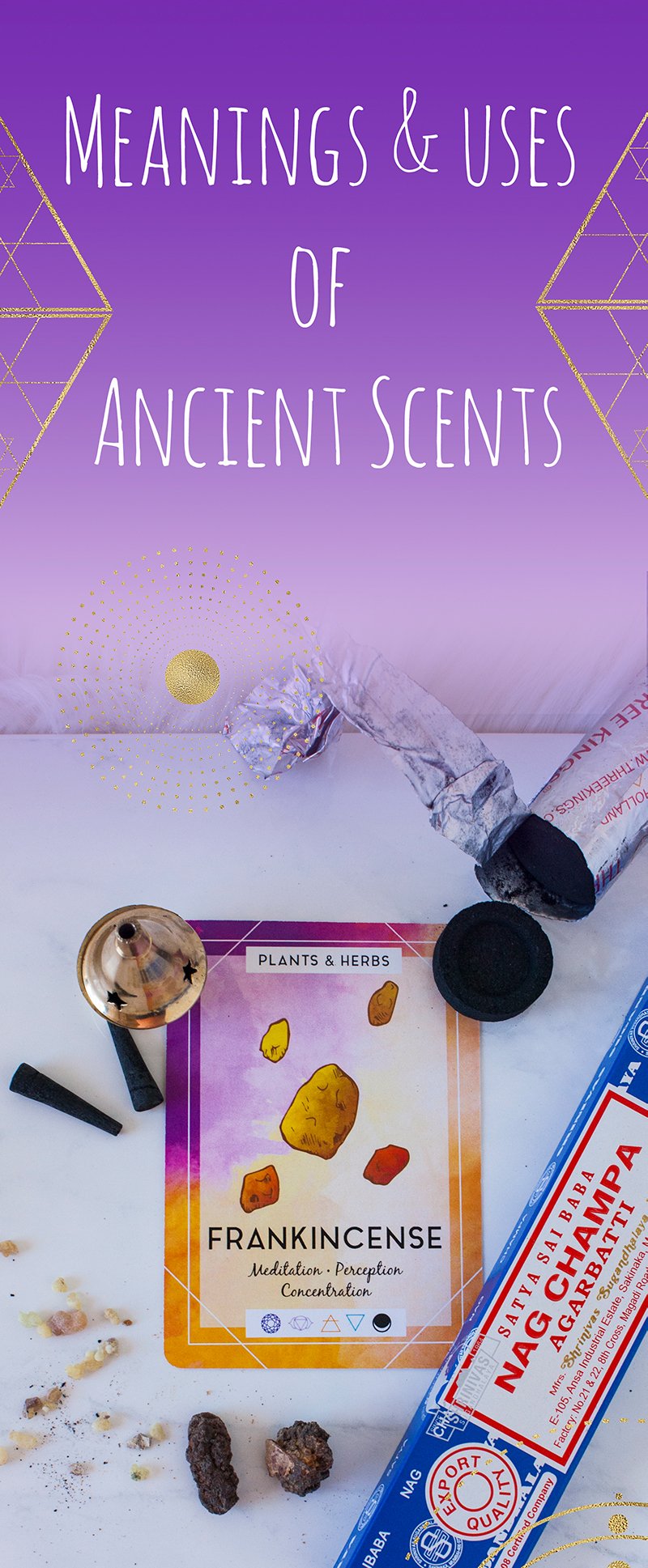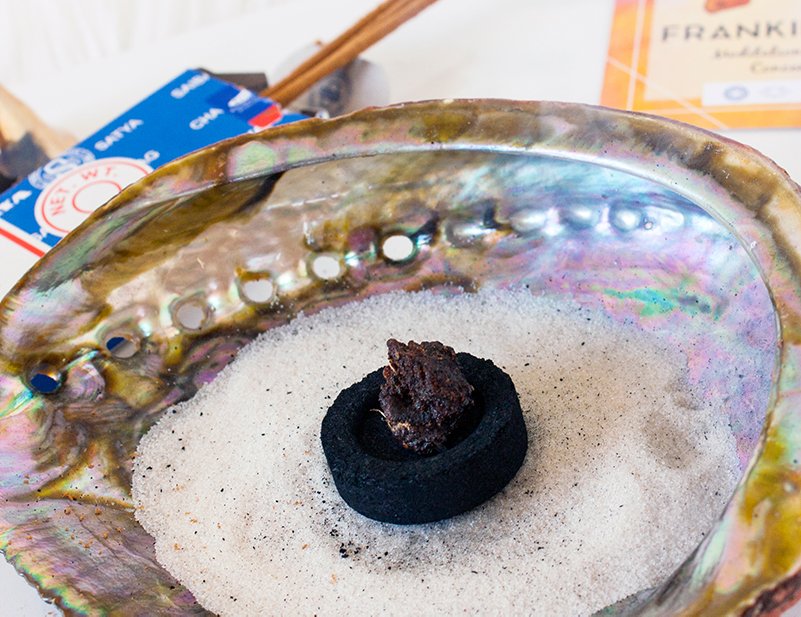Ancient Scents & Their Meanings
Have you ever smelled something and it took you back to a specific moment in your life or a certain feeling?
We can’t always explain why scents attach themselves to moments in our lives and stick, but we know that scents are powerful.
Think about how you feel when you smell fresh cut grass, the incense burning in your local yoga studio, onions sautéing on the stove, or winter candles burning.
Each one of those scents probably evokes a specific emotion in you.
This is the power of scents.
Smell is one of the most primal senses, and it can awaken the deep emotions that may be hiding in your cells.
Scents are a way to connect to our heart space. They’re a way to shift our energy, our emotions, and our mood. They can also be an incredible way to connect with the Universe or the Divine.
Some scents, such as the ones below, have their roots in ancient civilizations around the world. They’ve been used for their magickal healing properties in the ancient civilizations of India, Rome, China, Egypt, and more.
Why?
Scroll down to learn more about some of the most powerful ancient scents' meanings and uses.
Frankincense
Frankincense has been used for centuries in the Middle East (where it’s from), Egypt, Israel, Ancient Rome, Ancient Greece, other parts of Europe, and more.
In different cultures, it was used for different things:
As incense in sacred Jewish rituals, Christian ceremonies, and other religious ceremonies in Greece, Rome, Egypt, and Israel
Healing and purification in the Ayurvedic tradition
To drive insects away in the Middle East
Flavoring food and drinks in the Middle East
In burial rituals in Egypt and Rome
To treat medical issues including ulcers, nausea, post-childbirth recovery, chest coughs, and fever
To embalm bodies in Ancient Egypt
Besides its practical uses, it was revered as a powerful tool for protection, purification, and connecting with the divine.
How can you incorporate frankincense into your life today? Here are some ideas:
Burn frankincense resin as an offering to a goddess you’re working with
Use frankincense oil to anoint your candles in candle magick
Use frankincense oil (diluting with a carrier oil if needed!) on your wrists before meditation or ritual work
Rub the soles of your feet with frankincense oil before bed to help you relax
Diffuse frankincense oil on summer nights on your porch for a natural bug spray
Use frankincense oil as a perfume on your skin to imbue your day to day with some extra magic
Burn frankincense incense in your space to protect and purify it
Myrrh
Myrrh also comes from trees in the Middle East and North Africa, and was used alongside frankincense in the great ancient civilizations of Egypt, Israel, Europe, and the Middle East. Where frankincense is associated with the sun, myrrh is a bit murkier. It’s associated with the sun because its tree thrives in the desert sun, but it’s also associated with the moon, because of its strong feminine history as an herb for ancient goddesses.
Some of its historical uses are:
Embalming the dead in ancient Egypt
Used as medicine, especially with honey, in ancient Egypt for many illnesses, especially skin conditions, infections, and bruises
Burning as sacred incense in Christian traditions
Used in ancient Egyptian rites as an offering to the sun god Ra and goddess Isis
As a perfume and purification oil for the Hebrew people
For its restorative properties in Eastern medicine
Myrrh was used as a powerful tool for healing, protection, purification, meditation, and expanding inner wisdom. It was often used as a great complement to frankincense, and it’s thought that combining the two even increases their power.Try these ideas for incorporating myrrh into your life today:
Burn myrrh resin on your altar as an offering to the goddess Isis
Use in banishing and protection rituals and spells
Purify and bless magical tools such as your tarot cards, crystals, and talismans
Burn myrrh incense when you need personal healing and comfort
Use myrrh oil on your skin (diluting with carrier oil if necessary) to help you meditate
Incorporate into any of your work with frankincense above
Sandalwood
Sandalwood isn’t technically an herb. It’s actually, like the name suggests, a type of wood. Sandalwood has been used for thousands of years in many different contexts, including:
Buddhist rituals
Muslim rituals
Egyptian embalming rituals
Folk medicine in Tibet and China
In carvings for shrines and homes in India
In figurines and jewelry in India
As a paste for anointing in Hindu temples
As a perfume and soap in Europe
As a powerful remedy in the Ayurvedic system of medicine
Consecrating ritual tools in Hindu ceremonies
Practically, sandalwood has been used for its anti-inflammatory and cleansing properties. Magically and energetically, sandalwood has been used for many things including healing, purification, grounding while also assisting in meditation, clearing negativity, deep spiritual relaxation, clairvoyance, and manifestation.Some ways to use sandalwood in your life are:
Write your desires on a stick of sandalwood on the new moon and burn it, letting the smoke carry your desires into the universe
Cleanse your magical tools (like crystals, athames, cauldrons, and tarot cards) of negative energy
Burn sandalwood chips to help heal coughs and UTIs
Burn sandalwood incense for meditation
Burn sandalwood incense or chips for astral projection and communicating with spirits
Wear sandalwood beads for higher spiritual awareness
Nag Champa
If you’ve ever walked into a yoga studio or a witchy shop, you’ve probably smelled the earthy, slightly sweet scent of Nag Champa. But what is Nag Champa?
It’s a blend of different scents, most famously the champa flower, as well as sandalwood, and halmaddi resin. The champa flower from the Magnolia champaca tree, a tree often planted near ashrams, has long been prized in India for its sweet fragrance and bright yellow color.
As you’ve probably guessed, Nag Champa’s origins are as incense in India where it was often used for meditation, yoga, and rituals in Hindu temples and ashrams. It’s now one of the most popular incense scents in the world!
Nag Champa is thought to stimulate spiritual awareness while simultaneously grounding you in the present.
Here are some ideas for incorporating this popular scent into your life:
Burn Nag Champa when you meditate or do yoga
Use Nag Champa oil as a perfume
Burn Nag Champa for chanting and kirtan practices
Use Nag Champa oil to massage your feet (diluting if needed!)
Use Nag Champ soap or body wash (there are tons of options) to add some magic to your everyday







